Content
- Causes of a pinched nerve in the lower back
- Benefits of Injection Treatment
- Contraindications to injections
- Treatment injections
- Non-steroidal anti-inflammatory drugs (NSAIDs)
- Meloxicam (Movalis, Amelotex, Artrozan, Mirlox, Revmart)
- Ketoprofen (Ketonal, Artrosilene, Flamax)
- Diclofenac (Voltaren, Diklobene, Diklovit, Dorosan, Ortofen)
- Analgesics
- Vitamins
- Milgamma (Binavit, Vitaxon, Kombilipen, Larigamma)
- Muscle relaxants
- Tolperisone (Midocalm)
- Hormonal injections (steroids)
- Diprospan
- Hydrocortisone
- Prednisone
- Kenalog
- Healing blockades
- Chondroprotectors
- Chondroitin sulfate
- Alflutop
- Drugs that improve blood microcirculation
- Selection of injectable drugs with an established cause of a pinched nerve in the lower back
- Intervertebral hernia
- Osteochondrosis, curvature of the spine, marginal bone growths of the vertebral bodies
- Displacement of the vertebrae (listez)
- Neoplasms of the spine, small pelvis, gluteal region
- Inflammation of the pelvic organs
- Thrombosis of nearby vessels
- Muscle inflammation and edema
- Piriformis syndrome
- Video about injections with a pinched nerve
Injections when a nerve is pinched help get rid of acute lower back pain. Radiculopathy is conventionally divided into 3 types: chronic, acute, subacute. The symptom complex of pathology may vary depending on the stage of the course.
Causes of a pinched nerve in the lower back
There can be several reasons for the development of radiculopathy.
People are at risk:
- whose work activity is associated with physical exertion and exposure to the vibration field;
- obese;
- with a history of spinal injury;
- leading a sedentary lifestyle;
- consuming alcoholic beverages and tobacco products;
- being in a prolonged stressful situation.
Also, a risk factor can be considered a genetic predisposition (the presence of radicular pain in close relatives). A pinched nerve in the spine can develop due to dystrophic or degenerative changes (narrowing of the canal, wear of ligaments and joints, the formation of hernias). An intervertebral hernia can be considered the most common cause of radiculopathy - the nucleus penetrates into the annulus fibrosus due to strong pressure.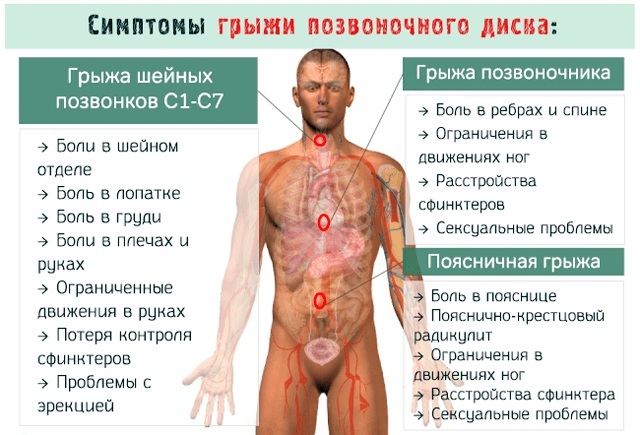
Ankylosing spondylitis, osteoarthritis, arthritis of rheumatic, rheumatoid and gouty nature can also be considered the cause of the development of pinching. Often, pathology is diagnosed in elderly patients. It can be provoked by age-related changes in ligaments, muscles and bones.
Also, the causes of the development of the disease include pathologies of an infectious nature:
- HIV;
- herpes;
- tuberculosis;
- osteomyelitis.
People with diabetes are more likely to get pinched nerve roots. Metastases or neuromas can lead to the development of pathology.
Severe pain isn't just due to nerve compression. The clinical syndrome is caused by a disorder of metabolic processes in the tissues of the spine, a decrease in protective immune reactions and the release of toxins caused by damage to damage to the structures of the spine and nerves.
Benefits of Injection Treatment
According to reviews, drugs in the form of solutions are more effective than tablets. When injected intramuscularly, the active components quickly penetrate into the bloodstream and are evenly distributed over tissues and cells. Medicines included in the therapy have a predominantly anti-inflammatory, analgesic effect.
Contraindications to injections
The drugs included in drug therapy for pinched nerves have a number of general contraindications. It is strictly forbidden to inject intramuscularly for severe kidney and liver damage. Individual intolerance to the main, auxiliary components and childhood are considered absolute restrictions on use. Elderly patients, pregnant and lactating women may need to adjust the dosage regimen.
Treatment injections
Injections with a pinched nerve in the lower back can be roughly divided into several categories, depending on the mechanism of action.
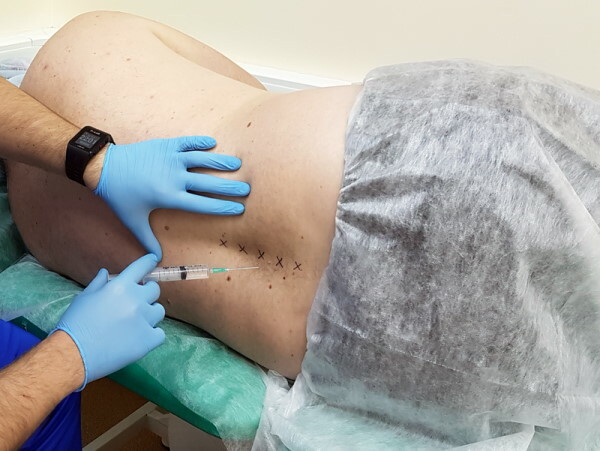
The composition of drug therapy may include drugs:
| Category | Name of drugs |
| NSAIDs | Meloxicam (Movalis, Amelotex, Artrozan, Mirlox, Revmart) |
| Ketoprofen (Ketonal, Artrosilene, Flamax) | |
| Diclofenac (Voltaren, Diklobene, Diklovit, Dorosan, Ortofen) | |
| Analgesics | Novocaine |
| Lidocaine | |
| Analgin | |
| Vitamins | Milgamma (Binavit, Vitaxon, Kombilipen, Larigamma) |
| Muscle relaxants | Tolperisone (Midocalm) |
| Hormonal drugs | Diprospan |
| Hydrocortisone | |
| Prednisone | |
| Kenalog |
Injections with a pinched nerve in the lower back work faster than pills. The use of medicines should be carried out strictly according to the instructions. It is strictly forbidden to independently select drugs, relying on advertising or advice from friends.
Non-steroidal anti-inflammatory drugs (NSAIDs)
The principle of action of drugs in this category is based on the ability of active ingredients to block cyclooxygenase (enzyme), inhibiting the synthesis of prostaglandins (mediators of inflammation and pain). The drugs are characterized by a local antipyretic, anti-inflammatory and mild analgesic effect.
Non-steroidal anti-inflammatory drugs are not classified as hormonal drugs. The drugs act quickly, the therapeutic effect lasts for a long time.
Meloxicam (Movalis, Amelotex, Artrozan, Mirlox, Revmart)
The drug is marketed in the form of a solution for injection and tablets. The active ingredient is the substance of the same name.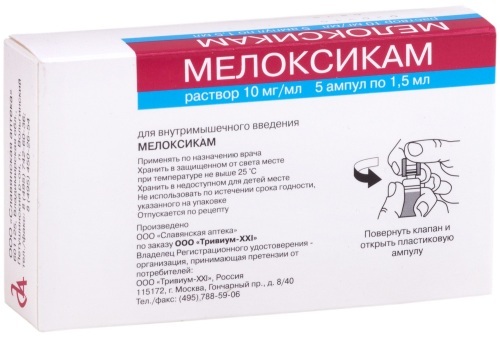
Auxiliary elements:
- sodium dihydrate;
- magnesium salt of stearic acid;
- colloidal silicon;
- microcellulose.
The solution for intramuscular administration is strictly prohibited to be used intravenously and taken orally. The funds are prescribed for children over 15 years old and adults. The daily rate is no more than 15 mg. The solution is injected into the gluteus muscle. If the individually selected regimen of use is not followed, the risk of side effects is quite high.
Patients complain of allergic reactions, dizziness, headache, drowsiness, dyspeptic disorders. Seals may occur at the injection site.
Revmart, Mirlox, Artrozan, Amelotex, Movalis can be considered structural analogs of Meloxicam. The scheme for using the above drugs - no more than 2 ampoules of the solution can be administered to the patient per day.
Ketoprofen (Ketonal, Artrosilene, Flamax)
Ketoprofen, Flamax, Artrosilene and Ketonal are drugs with a similar therapeutic effect. They are marketed in the form of solutions for injection (some drugs have other forms as well). The active ingredient of medicines is ketoprofen (50, 100 mg).
Non-steroidal anti-inflammatory drugs have antipyretic, analgesic and anti-inflammatory effects. The main component inhibits the synthesis of pain and inflammation mediators. All of the above medicines are highly bioavailable.
When the nerve roots in the lower back are pinched, injections are usually prescribed to patients. The solution is administered intramuscularly and intravenously. Therapeutic dose is no more than 100 mg (up to 2 times a day). The drug cannot be administered intravenously in a stream at home. In the hospital, the dosage forms are dissolved in sodium chloride (100 mg per 100 ml) and in Ringer's solution (100 mg per 500 ml), and injected drip.
The course of application is 2-3 days. You can repeat it after 5-7 days.
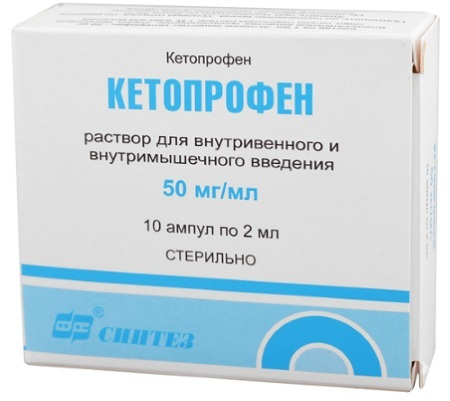
Side effects develop from the side:
- central nervous system - asthenia, insomnia, drowsiness, dizziness, headache,
- immunity - allergic reactions (including anaphylactic shock);
- organs of the digestive tract - dyspepsia, vomiting, bouts of nausea, constipation, flatulence.
If individually selected treatment regimens are followed, the risk of side effects is minimal.
Diclofenac (Voltaren, Diklobene, Diklovit, Dorosan, Ortofen)
Ortofen, Dorosan, Diklovit, Diklobene, Voltaren and Diclofenac belong to the category of non-steroidal anti-inflammatory drugs. You can buy these medicines in solution form at the pharmacy. The active ingredients, betamethasone and diclofenac, have anti-inflammatory, antipyretic and analgesic effects. When ingested, the components suppress the synthesis of mediators and disrupt the exchange of arachidonic acid.
Medicines should be used according to an individually selected scheme. Solutions are not administered intravenously at home. Therapeutic norm is no more than 1 ampoule. At least 12 hours should elapse between injections. The course of application is 2-3 days.
Side effects can occur from the side:
- nervous system - dizziness, drowsiness, irritability, headache;
- organs of the digestive tract - diarrhea, dyspepsia, bloating, constipation;
- cardiovascular system - surges in blood pressure, increased heart rate, pain in the sternum.
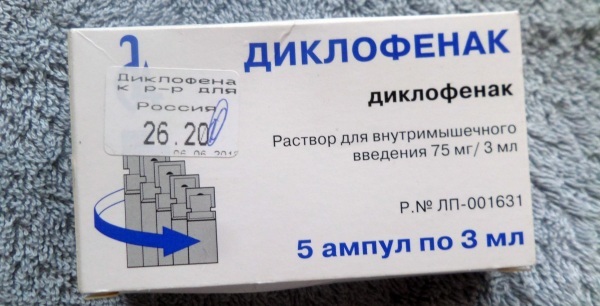
If any ailments occur after the administration of the solution, immediate discontinuation of the drug is required.
Analgesics
Injections with a pinched nerve in the lower back should have an analgesic effect. Drugs in this category are usually broad-spectrum. They have moderate analgesic activity. Most medications are capable of blocking sodium channels, thereby preventing nerve impulses from passing through the fibers.
Medicines have an analgesic effect by eliminating muscle spasms. They are characterized by a short anesthetic activity (no more than 2-3 hours). Analgesics for pinched nerves in the lower back are not prescribed for children under 12 years of age. An absolute contraindication is also hypersensitivity to one or another active ingredient. Elderly patients require careful use.
A solution of Lidocaine and Novocaine is administered intramuscularly. The therapeutic dose directly depends on the age and condition of the patient. Side effects can occur from the digestive tract, urinary, respiratory, cardiovascular and central nervous systems. Most often, patients complain of pain at the injection site and allergic reactions (rashes, itching, urticaria).
Vitamins
Vitamins are usually included in drug therapy for pinched nerves in the lower back. Medicines in this category have high bioavailability. Vitamins of group B are mainly injected intramuscularly.
Medicines have an immunomodulatory, immunostimulating effect. The active ingredients in the preparations start the regeneration process at the cellular level. Under their influence, metabolism is restored. Also vitamins are responsible for the elimination of pain.
Milgamma (Binavit, Vitaxon, Kombilipen, Larigamma)
Vitamin complexes Larigamma, Kombilipen, Vitaxon, Binavit and Milgamma can be included in drug therapy for pinching the sciatic nerve. The drugs have the same composition and approximately the same scheme of use.
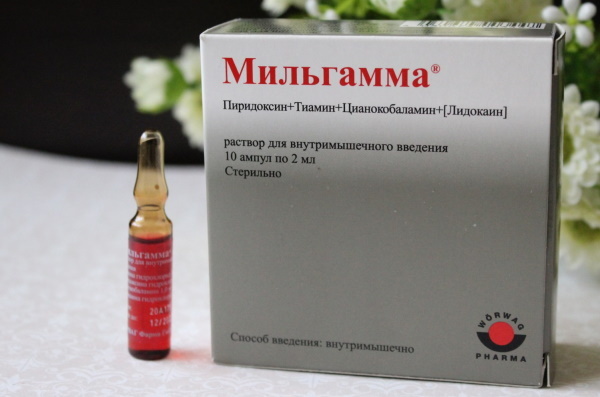
The solution is injected into the gluteus muscle. Therapeutic norm is 2 ml. The course of application is 7-10 days. If the drug was prescribed to the patient during the recovery period after the main therapy, then the injections are made no more than 2-3 times a week.
Muscle relaxants
Muscle relaxants are broad-spectrum drugs. They are responsible for slowing down the synthesis of synapse mediators. Under the influence of drugs, blood flow accelerates in the affected area. For medicines, a vasodilating effect is characteristic.
Muscle relaxants have a more soothing effect. Medicines reduce hypertonicity, spasticity and stiffness of muscle fibers. For muscle relaxants, a mild antispasmodic effect is characteristic. The drugs do not have a pronounced effect on the parts of the central nervous system.
Tolperisone (Midocalm)
The drug is marketed in the form of a solution. Children under 18 years of age are not prescribed medication. The solution requires parenteral administration (intramuscularly, intravenously). At home, the solution is usually injected into the gluteus muscle 1-2 times a day. The daily norm is no more than 200 mg, which is equivalent to 2 ampoules.
Intravenous administration is carried out in a hospital setting. The daily rate of Tolperisone in this case should not exceed 100 mg (1 ampoule). The course of application is determined by the attending physician, depending on the age of the patient and the stage of the course of the disease. People suffering from impaired functional activity of the kidneys and liver are prescribed another, weaker drug.
Hormonal injections (steroids)
Injections of hormonal drugs with a pinched nerve in the lower back are prescribed only in the absence of contraindications. For medicines in this category, a wide range of effects is characteristic. Most often, hormonal drugs are prescribed if NSAIDs, analgesics have not helped. For medicines in this category, anti-inflammatory and analgesic effects are also characteristic. The drugs quickly relieve puffiness.
Diprospan
Diprospan, which is marketed in the form of a solution, requires intramuscular, intraarticular and periarticular administration. The drug can also be used intradermally. The dosage regimen and the course of administration are selected individually, depending on the severity of the disease.
When administered intramuscularly, the therapeutic dose is 4-6 mg once. The solution of Diprospan must be diluted in dextrose or sodium chloride for infusion. The therapeutic norm of the drug intraarticular and periarticular is no more than 6 mg once.
Hydrocortisone
Glucocorticosteroid of natural origin has immunosuppressive, anti-allergic and anti-inflammatory effects.
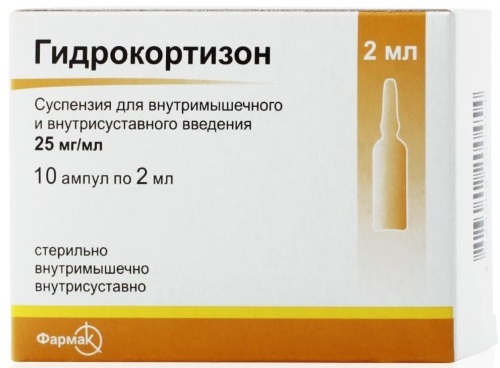
Hydrocortisone is often included in drug therapy for chronic radiculopathy. The solution is administered intra-articularly or intramuscularly. Therapeutic dose is not more than 1000 mg. It is advisable to divide it into several applications.
Prednisone
Prednisolone is a solution for systemic or local use. The drug is characterized by a prolonged action. The dosage regimen should be selected by the attending physician. The solution is administered intraarticularly, intramuscularly and intravenously. In severe cases, for example, with an exacerbation of radiculopathy, characterized by severe pain and impaired motor activity, the drug is administered drip. The therapeutic dose is 1-2 g. The course of application is usually 2-4 days.
Kenalog
The drug solution must be injected deep into the muscle. The daily dose of the medication is 80 mg (2 ampoules). It is advisable to divide it into 2 applications. 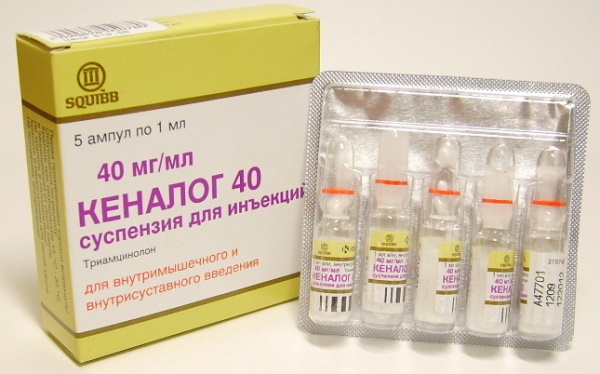 Re-injection is injected after 2-3 weeks, if necessary.
Re-injection is injected after 2-3 weeks, if necessary.
Healing blockades
Medical blockade is performed in case of emergency if the pills and injections did not help. Diprospan, Novocaine or Lidocaine are injected into the damaged area.
Algorithm of the procedure:
- the patient lies down on the couch, bending the knees and pressing the heels tightly to each other;
- by palpation, the doctor draws a line from the trochanter (the head of the femoral bone) to the pelvic ilium;
- exactly in the center, the doctor finds a point and draws a line up to the tailbone;
- the specialist marks the end of the line and at this point injects 10% of the medication for 60 seconds.
The needle is advanced deeper into the tissues only after the patient complains of numbness. Subject to all the rules of septic and asepsis, complications do not arise. Only an experienced specialist should carry out the procedure. In this case, the risk of vascular damage is minimal.
Chondroprotectors
Drugs in this category are able to suppress the synthesis of enzymes that affect the articular cartilage. Chondroprotectors are also responsible for the restoration of metabolic processes in the tissue, and has a beneficial effect on calcium metabolism inside the bones. Medicines start the regeneration process at the cellular level. The drugs are characterized by analgesic and anti-inflammatory effects. Chondroprotectors inhibit the synthesis of pain and inflammation mediators (prostaglandins).
Chondroitin sulfate
The drug is injected deep into the muscle. Therapeutic dose is 100 mg once. Injections are administered once every 2 days. If the patient tolerates the treatment well, then the dose can be doubled. Chondroitin sulfate must be diluted in water for injection (1 ampoule - 1 ml of water).  The course of application includes up to 35 injections. You can repeat it after 6-7 months.
The course of application includes up to 35 injections. You can repeat it after 6-7 months.
Alflutop
The course of application of the chondroprotector varies within 20-24 days. The solution can be administered intra-articular, periarticular, paravertebral and intramuscular. The therapeutic dose for adult patients should not exceed 2 ml.
Drugs that improve blood microcirculation
Injections with a pinched nerve in the lower back usually help restore blood flow to the affected area. Drugs in this category are prescribed in addition to analgesics. Derivatives of nicotinic acid (B3, PP, niacin) can be included in drug therapy.
Means thin the blood, expand the vascular lumen, have an antitoxic and antioxidant effect. The dosage regimen and dosage regimen is selected individually, depending on the severity of the pathology and the patient's age.
Selection of injectable drugs with an established cause of a pinched nerve in the lower back
The selection of medicines should be carried out individually. Usually, non-steroidal anti-inflammatory drugs, vitamins, chondroprotectors are included in the drug therapy. Hormonal drugs are prescribed only in case of emergency.
Intervertebral hernia
For intervertebral hernias, doctors usually prescribe drugs in the following category:
- Non-steroidal anti-inflammatory drugs (Revmart, Artrozan, Artrozilen, Ortofen, Voltaren, Diklovit);
- Muscle relaxants (Sirdalud, Midocalm);
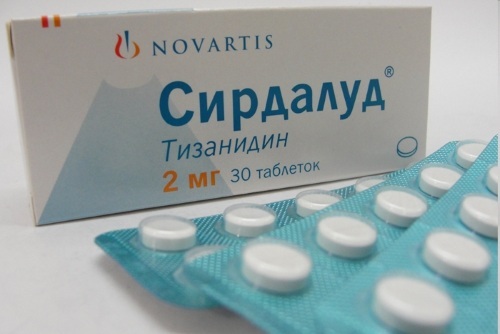
- Vitamin complexes (Kombilipen, Vitaxon, Milgamma).
Also, to relieve pain, patients can use local medications - thermoplastics, ointments, gels (Ketonal, Fastum-gel, Viprosal, Diclofenac).
Osteochondrosis, curvature of the spine, marginal bone growths of the vertebral bodies
For patients suffering from scoliosis or osteochondrosis, experts recommend daily performing a set of therapeutic exercises.
They also select drug therapy, which includes:
- Non-steroidal anti-inflammatory drugs (Nise, Diclofenac, Ibuprofen);
- Analgesics (Lidocaine, Novocaine);
- Muscle relaxants (Midocalm, Sirdalud);
- Chondroprotectors (Teraflex, Dona);
- Vitamin complexes (Thiamin, Pyridoxine).
In order to restore blood flow in the affected part of the lower back, Pentoxifylline is prescribed
Displacement of the vertebrae (listez)
With listez, patients are prescribed anti-inflammatory nonsteroidal drugs and physiotherapy procedures. If a person experiences pain for a long time and at the same time pills and injections do not help him, then an epidural injection of cortisone is necessary. Also, patients are prescribed to wear a corset.
Neoplasms of the spine, small pelvis, gluteal region
Medical treatment for the growth of tumors of a malignant or benign type in the pelvic and spine areas will not help. Patients are prescribed radiation and chemotherapy. In most cases, surgical or minimally invasive intervention is indicated.
Inflammation of the pelvic organs
Inflammatory diseases are usually treated with antibiotics. Drugs in this category have antibacterial and mild antipyretic effects. The most effective drugs for inflammation are cephalosporin antibiotics. Also, non-steroidal anti-inflammatory drugs can be included in the drug therapy.
Thrombosis of nearby vessels
In case of thrombosis or if it is suspected of it, the patient is prescribed medications that help strengthen the vascular walls. Most medicines in this category contain aspirin or its derivatives.
Antiplatelet agents that can be part of drug therapy:
- Clopidogrel;
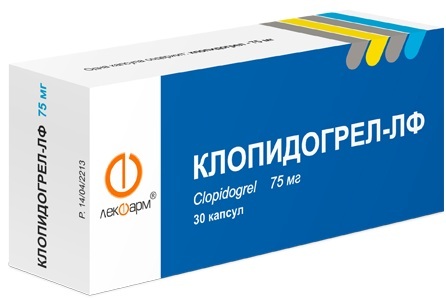
- Aspirin;
- Thrombital;
- Warfarin.
Also, patients may be prescribed blood thinning drugs (Heparin, Fraxiparin in the form of a solution for injection).
Muscle inflammation and edema
Myositis (muscle inflammation), especially during an exacerbation, is accompanied by impaired motor activity. Patients are required to comply with bed rest.
Drug therapy includes:
- Non-steroidal anti-inflammatory drugs (Diclofenac, Ibuprofen, Ketoprofen);
- Warming ointments (Finalgon, Fastum-gel).
With severe pain syndrome, intramuscular administration of Lidocaine and Novocaine is allowed.
Piriformis syndrome
With piriformis syndrome, hormones or anesthetics are injected into the affected area.
The following medications may be included in the therapy:
- Dexamethasone;
- Diprospan;
- Lidocaine;
- Novocaine.
SHM requires complex treatment. The patient is usually prescribed mild antidepressants - medications that have a calming effect. Also, muscle relaxants and non-steroidal anti-inflammatory drugs have proven themselves well in the treatment of SHM.
Injections prescribed for a pinched nerve are not recommended to be given on your own, even with experience. With severe lower back pain, patients are shown bed rest. The introduction of solutions intramuscularly requires compliance with the rules of asepsis and antiseptics.
Video about injections with a pinched nerve
Remedies for back pain if the sciatic nerve is pinched:
